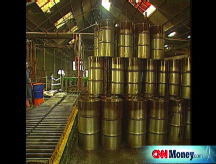Ford's trouble: $4 gas is here to stay
Gas prices are causing consumers to shun pickups and SUVs, leading to losses at the car maker's North American auto unit.
NEW YORK (CNNMoney.com) -- Ford Motor Co. executives say they believe that $4 gas is here to stay, resulting in a fundamental consumer shift away from gas-guzzling SUVs and pickups and causing continued losses at its core North American auto unit.
The company said it expects gas prices to remain in the range of $3.75 to $4.25 a gallon through the end of 2009. And that expectation prompted the nation's No. 3 automaker to announce deep production cuts for what has been its best selling and most profitable vehicles for several decades and could lead to more plant closings and job cuts down the road.
"We saw a real change in the industry demand in pickups and SUV in the first two weeks of May," said Ford Chief Executive Alan Mulally. "It seems to us we reached a tipping point."
Ford now believes that the change in vehicle choice is structural, not cyclical, Mulally said. Ford reduced its forecast for industrywide sales and said its own market share will now be about 14% of retail sales, at the low end of its earlier forecast.
He warned that Ford now doubts it will be able to hit its longheld goal of returning its North American unit to profitability by 2009. The company said it hopes to break even companywide next year as overseas profits balance out losses at home.
Shares of Ford (F, Fortune 500) plunged nearly 7% in mid-afternoon trading after the announcement.
"I think it's a concession to reality," said auto analyst David Healy of Burnham Securities. "General Motors (GM, Fortune 500) has done the same thing, just not with the publicity. Chrysler has been quietly cutting production. But it's a good idea to get all the bad news out at once."
Healy said it was smart for Ford to make the change sooner rather than later, even if there is some debate as to how long oil prices will stay this high.
"Even with all the plant closings in recent years, they probably still have too much capacity for the outlook," he said. "Even if there's speculation in the oil markets and the price of crude is vulnerable, you can't base your business plan on it going down."
Stay tuned: More changes coming
Mulally said the company in July will detail longer-term changes, including personnel reductions. Ford had already offered buyouts and early retirement to all of its U.S. hourly employees earlier this year. But that was done not so much to cut headcount but to replace high-paid senior employees with costly benefit packages with lower-paid new hires with less expensive heath and retirement plans. There are also targeted buyout offers at two plants slated for closure.
Ford said it will ramp up production of some other models such as cars and so called crossovers, a vehicle designed to bring a more car-like ride to SUVs. But the cuts in its pickup and SUV output will be greater than its increased car production.
Ford trimmed an additional 20,000 vehicles, or 3%, from its North American plans, for the second quarter, putting its target at 690,000 vehicles. That will leave output down 15% from year-ago levels.
The company said it now plans to produce between 510,000 and 540,000 units in the third quarter, down 15-20% from the same period last year, while the fourth-quarter production target is now between 590,000 and 630,000 units, down 2-8% from year-earlier levels.
Mulally said the company has no plans to abandon large vehicles. He believes pickup sales will improve once the battered home building market starts to recover, and that there will always be some demand for large SUV's due to their towing and hauling capability.
But the shift in vehicle choice by consumers is bad news for the nation's No. 3 automaker, which has lost money on its North American auto operations since 2005.
Ford has seen the traditional pickups and mid- to full-size SUV's decline significantly as a percentage of its sales. Through the first four months of the year, U.S. sales of those models fell 16% compared to a year earlier, while all the other models saw only a 5% decline that was slightly less than the industrywide sales slump. The traditional pickups and SUV's made up just over a third of Ford's U.S. sales year to date. As recently as 2004, they accounted for more than half its sales.
More smaller cars in store
The company plans to ramp up production of smaller cars and crossovers: Ford Focus, Fusion, Edge and Escape, the Mercury Milan and Mariner, as well as the Lincoln MKZ and Lincoln MKX. These models generally cost less and have lower profit margins than the light truck models for which Ford is cutting production, such as the F-Series pickup, still the nation's best selling vehicle.
Also since the car models cannot be built on the same assembly lines where the pickups and SUV are built, the decreased production will mean more idled plants. Ford likely will have to pay employees who are not working while it increases the hours for those at car plants.
Also Thursday Ford said it was not taking a position on a previously-announced proposal by investor Kirk Kerkorian to buy an increased stake in Ford. ![]()






